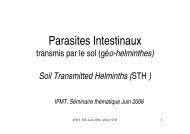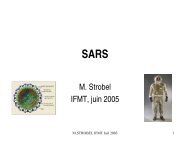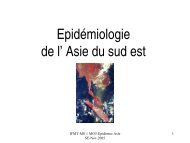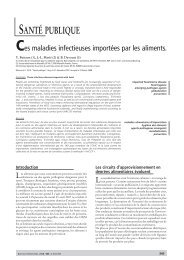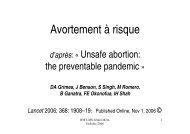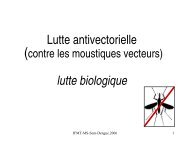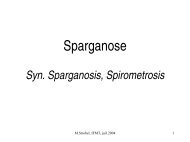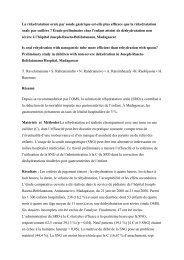risk factors for epilepsy in rural laos - Institut de la francophonie pour ...
risk factors for epilepsy in rural laos - Institut de la francophonie pour ...
risk factors for epilepsy in rural laos - Institut de la francophonie pour ...
You also want an ePaper? Increase the reach of your titles
YUMPU automatically turns print PDFs into web optimized ePapers that Google loves.
RISK FACTORS OF EPILEPSY IN RURAL LAO PDR<br />
RISK FACTORS FOR EPILEPSY IN RURAL LAOS:<br />
A CASE-CONTROL STUDY<br />
Duc Si Tran 1,2 , Peter O<strong>de</strong>rmatt 1,3 , Le Thi Oanh 1 , Pierre Huc 2 , Niranh Poum<strong>in</strong>dr 4 , Akira Ito 5 ,<br />
Michel Druet-Cabanac 2 , Pierre-Marie Preux 2 and Michel Strobel 1<br />
1<br />
<strong>Institut</strong> <strong>de</strong> <strong>la</strong> Francophonie <strong>pour</strong> <strong>la</strong> Mé<strong>de</strong>c<strong>in</strong>e Tropicale, Vientiane, Lao PDR;<br />
2<br />
<strong>Institut</strong> d’épidémiologie Neurologique et <strong>de</strong> Nneurologie Tropicale (EA 3174), Limoges,<br />
France; 3 Department of Public Health and Epi<strong>de</strong>miology, Swiss Tropical <strong>Institut</strong>e, Basel,<br />
Switzer<strong>la</strong>nd; 4 Faculty of Medical Sciences, National University of Laos, Vientiane, Lao PDR;<br />
5<br />
Department of Parasitology, Asahikawa Medical College, Asahikawa, Japan<br />
Abstract. The objects of this study was to assess the major etiologic categories of <strong>epilepsy</strong> <strong>in</strong><br />
a <strong>rural</strong> district of the Lao PDR. Thirty-one newly i<strong>de</strong>ntified patients with confirmed active <strong>epilepsy</strong><br />
were compared with 124 controls, matched <strong>for</strong> gen<strong>de</strong>r, age and vil<strong>la</strong>ge resi<strong>de</strong>nce. Risk<br />
<strong>factors</strong> <strong>for</strong> <strong>epilepsy</strong> were <strong>in</strong>vestigated with particu<strong>la</strong>r focus on taeniasis and cysticercosis serology.<br />
A history of head trauma (OR=4.7, p=0.05), family history of <strong>epilepsy</strong> (OR=12.8, p=0.03),<br />
and the use of human feces to fertilize domestic vegetable gar<strong>de</strong>ns (OR=4.9, p=0.04) were<br />
significantly associated with <strong>epilepsy</strong>. The study did not confirm any direct re<strong>la</strong>tion between<br />
<strong>epilepsy</strong> and cysticercosis serology. The cysticercosis seroprevalence was 4.8% <strong>in</strong> the control<br />
group, but nil <strong>in</strong> the <strong>epilepsy</strong> group. This is the first study <strong>in</strong> the Lao PDR on <strong>epilepsy</strong> <strong>risk</strong><br />
<strong>factors</strong> represent<strong>in</strong>g important data <strong>for</strong> the sub-region. Parasitic, environmental, and behavioral<br />
<strong>factors</strong> of this traditional popu<strong>la</strong>tion <strong>de</strong>serve further studies to exp<strong>la</strong><strong>in</strong> the miss<strong>in</strong>g l<strong>in</strong>k<br />
between <strong>epilepsy</strong> and taeniasis and cysticercosis<br />
INTRODUCTION<br />
Epilepsy is a worldwi<strong>de</strong> public health problem<br />
with an estimated global prevalence around<br />
8 per thousand (WHO, 2005). In tropical countries<br />
this prevalence is much higher, between<br />
10 0 and 15 0 accord<strong>in</strong>g to the International<br />
League Aga<strong>in</strong>st Epilepsy, reach<strong>in</strong>g up to 50 0<br />
<strong>in</strong> particu<strong>la</strong>r areas (Commission on Tropical Diseases<br />
of ILAE, 1994; <strong>de</strong> Bittencourt et al, 1996;<br />
Preux and Druet-Cabanac, 2005).<br />
A majority of <strong>epilepsy</strong> cases are consi<strong>de</strong>red<br />
idiopathic. Secondary (or symptomatic)<br />
<strong>epilepsy</strong> results from various conditions: per<strong>in</strong>atal<br />
distress, head trauma, cerebrovascu<strong>la</strong>r<br />
disease, bra<strong>in</strong> tumours, and central nervous<br />
Correspon<strong>de</strong>nce: Peter O<strong>de</strong>rmatt, Swiss Tropical<br />
<strong>Institut</strong>e, Postfach, 4002 Basel, Switzer<strong>la</strong>nd.<br />
Tel: +41-61-284 82 14; Fax: +41-61-284 81 05<br />
E-mail: peter.o<strong>de</strong>rmatt@unibas.ch<br />
system (CNS) <strong>in</strong>fections (Arruda, 1991; Hui<br />
and Kwan, 2004; Miskov et al, 2005). The<br />
prevalence of these conditions is <strong>de</strong>term<strong>in</strong>ed<br />
<strong>in</strong> each area by <strong>factors</strong> <strong>in</strong>clud<strong>in</strong>g environment,<br />
cultural practices, quality of prevention and<br />
care, and socio-economic <strong>de</strong>velopment. Accord<strong>in</strong>g<br />
to the ILAE (Commission on Tropical<br />
Diseases of ILAE, 1994) CNS <strong>in</strong>fections are<br />
the lead<strong>in</strong>g cause of <strong>epilepsy</strong> <strong>in</strong> tropical <strong>de</strong>velop<strong>in</strong>g<br />
countries, and <strong>in</strong>clu<strong>de</strong> tuberculosis,<br />
schistosomiasis, AIDS, and cysticercosis; the<br />
<strong>la</strong>tter rank<strong>in</strong>g number one <strong>in</strong> many areas.<br />
Epilepsy prevalence data are scarce <strong>in</strong><br />
Southeast Asia, but have shown rates around<br />
8 0 or below, which are unexpectedly low <strong>for</strong><br />
areas where taeniasis due to Taenia solium has<br />
been documented (Erhart et al, 2002;<br />
Will<strong>in</strong>gham et al, 2003; Rajshekhar et al, 2003;<br />
Rajshekhar et al, 2004; Dorny et al, 2004;<br />
Murrell et al, 2004; Joshi et al, 2004; Chen et<br />
Vol 38 No. 3 May 2007 1
SOUTHEAST ASIAN J TROP MED PUBLIC HEALTH<br />
al, 2004; Tran et al, 2006; Ito et al, 2005;<br />
Somers et al, 2006).<br />
We per<strong>for</strong>med a case-control study <strong>in</strong><br />
<strong>rural</strong> Lao PDR to assess the ma<strong>in</strong> <strong>de</strong>term<strong>in</strong>ants<br />
of <strong>epilepsy</strong>, with a special focus on cysticercosis<br />
serology.<br />
MATERIALS AND METHODS<br />
Study area<br />
The study was carried out <strong>in</strong> eight vil<strong>la</strong>ges<br />
of the H<strong>in</strong>heub District, Vientiane Prov<strong>in</strong>ce, Lao<br />
PDR. The district is located 120 km north of<br />
Vientiane capital town. Rice farm<strong>in</strong>g, gar<strong>de</strong>n<strong>in</strong>g,<br />
fish<strong>in</strong>g and breed<strong>in</strong>g, notably pig rear<strong>in</strong>g,<br />
are the ma<strong>in</strong> subsistence activities of these<br />
communities.<br />
Def<strong>in</strong>ition and i<strong>de</strong>ntification of cases and controls<br />
A two-step community screen<strong>in</strong>g was<br />
used to i<strong>de</strong>ntify and ascerta<strong>in</strong> the frequency<br />
of <strong>epilepsy</strong> cases (Preux et al, 2000; Tran et<br />
al, 2006); terms and c<strong>la</strong>ssification accord<strong>in</strong>g<br />
to recommendation of the Commission on Epi<strong>de</strong>miology<br />
and Prognosis of the International<br />
League Aga<strong>in</strong>st Epilepsy (ILAE, 1993). A total<br />
of 33 new patients with active <strong>epilepsy</strong> (<strong>la</strong>st<br />
seizure with<strong>in</strong> 5 years) were confirmed among<br />
4310 <strong>in</strong>terviewed vil<strong>la</strong>gers, of whom 31 consented<br />
to participate <strong>in</strong> the study. For each<br />
case, four controls were matched <strong>for</strong> gen<strong>de</strong>r,<br />
age (± 5 years) and vil<strong>la</strong>ge resi<strong>de</strong>nce.<br />
Procedures <strong>in</strong> cases and controls<br />
Cases and controls were <strong>in</strong>terviewed regard<strong>in</strong>g<br />
<strong>risk</strong> <strong>factors</strong> <strong>for</strong> <strong>epilepsy</strong>. The questionnaire<br />
addressed family history of <strong>epilepsy</strong>,<br />
per<strong>in</strong>atal events (from the care taker of the<br />
children), history of head trauma, and <strong>risk</strong> <strong>factors</strong><br />
<strong>for</strong> cysticercosis and taeniasis, <strong>in</strong>clud<strong>in</strong>g<br />
the presence of pigs <strong>in</strong> the household, the use<br />
of <strong>la</strong>tr<strong>in</strong>es, the consumption of pork meat, and<br />
the use of human feces as fertilizer.<br />
Each subject un<strong>de</strong>rwent a general and<br />
neurological cl<strong>in</strong>ical exam<strong>in</strong>ation. Bra<strong>in</strong> CT<br />
scans and other imag<strong>in</strong>g procedures were not<br />
avai<strong>la</strong>ble <strong>for</strong> cases of controls. Each subject<br />
provi<strong>de</strong>d a stool sample, which was preserved<br />
<strong>in</strong> sodium-acetyl-<strong>for</strong>mal<strong>in</strong> solution and exam<strong>in</strong>ed<br />
us<strong>in</strong>g a standard concentration technique<br />
(Yang and Scholten, 1997). Venous blood (5<br />
ml) was drawn from all subjects, and the serum<br />
was stored at 4ºC <strong>for</strong> 6 hours, then frozen<br />
at -20ºC. Frozen sera were flown <strong>in</strong> dry<br />
ice to Asahikawa Medical School, Japan.<br />
In Japan, ELISA and Immunoblot were<br />
<strong>in</strong><strong>de</strong>pen<strong>de</strong>ntly carried out by a simi<strong>la</strong>r procedure,<br />
except that the antigens used were<br />
isoelectrically purified glycoprote<strong>in</strong>s (GPs)<br />
(Roto<strong>for</strong>, BioRad, USA) extracted from T.<br />
solium glycoprote<strong>in</strong>s (Ito et al, 1998).<br />
Statistical analysis<br />
Data was entered <strong>in</strong> Epidata freeware,<br />
version 3.02 (www.epidata.dk, O<strong>de</strong>nse Denmark)<br />
and analyzed with STATA, version 8.2<br />
(Stata Cooperation, College Station, TX, USA).<br />
Proportions, means and their standard <strong>de</strong>viations<br />
were calcu<strong>la</strong>ted to compare cases and<br />
controls. Odd ratios and the 95% confi<strong>de</strong>nce<br />
<strong>in</strong>tervals were calcu<strong>la</strong>ted <strong>for</strong> the <strong>risk</strong> <strong>factors</strong><br />
us<strong>in</strong>g the matched analysis procedure. The<br />
significance threshold was set at 0.05.<br />
Ethical clearance was obta<strong>in</strong>ed from the<br />
M<strong>in</strong>istry of Health, Lao PDR. In<strong>for</strong>med consent<br />
was obta<strong>in</strong>ed from each of the subjects<br />
prior to enrollment <strong>in</strong> the study.<br />
RESULTS<br />
Study popu<strong>la</strong>tion<br />
A total of 31 newly diagnosed cases of<br />
active <strong>epilepsy</strong>, and 124 controls were enrolled.<br />
There were no significant differences between<br />
cases and controls <strong>in</strong> gen<strong>de</strong>r (p=1.00) or age<br />
(p=0.82). The male/female ratio was 1.2/1 <strong>for</strong><br />
both groups. The mean ages of cases and controls<br />
were 22.2 years (SD=12.5 years) and 22.7<br />
years (SD=11.8 years), respectively. All controls<br />
had their resi<strong>de</strong>ncy <strong>in</strong> the vil<strong>la</strong>ge of the correspond<strong>in</strong>g<br />
matched case.<br />
2 Vol 38 No. 3 May 2007
RISK FACTORS OF EPILEPSY IN RURAL LAO PDR<br />
Cl<strong>in</strong>ical <strong>de</strong>scription<br />
Generalized seizures (19 cases, 61.3%)<br />
were commoner than partial seizures (9 cases,<br />
29.0%); 3 cases (9.7%) were not-c<strong>la</strong>ssifiable;<br />
38.7% of patients had more than one seizure<br />
type, and the first seizure appeared be<strong>for</strong>e the<br />
age of 20 <strong>in</strong> 28 patients (90.3%). N<strong>in</strong>e patients<br />
(29.0%) had idiopathic <strong>epilepsy</strong>, 8 (25.8%) had<br />
symptomatic <strong>epilepsy</strong>, and 14 (45.2%) had<br />
cryptogenic <strong>epilepsy</strong>.<br />
Risk <strong>factors</strong> <strong>for</strong> <strong>epilepsy</strong><br />
Table 1 summarizes the ma<strong>in</strong> <strong>risk</strong> <strong>factors</strong>.<br />
A family history of <strong>epilepsy</strong> (OR=12.8, p=0.03),<br />
use of human-feces <strong>for</strong> fertilizer (OR=4.9,<br />
p=0.04), and a history of head trauma<br />
(OR=4.7, p=0.05) were significantly associated<br />
with <strong>epilepsy</strong>. Pork meat consumption was<br />
significantly less frequently reported <strong>in</strong> the<br />
<strong>epilepsy</strong> group than <strong>in</strong> controls (OR=0.1,<br />
p
SOUTHEAST ASIAN J TROP MED PUBLIC HEALTH<br />
from 1.5 to 17.0 fold, is re<strong>la</strong>t<strong>in</strong>g to the gravity<br />
of trauma (Annegers et al, 1998). Patients <strong>in</strong><br />
our study were young adults; most of them<br />
<strong>de</strong>veloped the disease dur<strong>in</strong>g childhood. Rural,<br />
mounta<strong>in</strong>ous environment and houses on<br />
piles exp<strong>la</strong><strong>in</strong> the high <strong>risk</strong> <strong>for</strong> trauma <strong>in</strong> these<br />
children.<br />
A positive family history of <strong>epilepsy</strong> is<br />
another c<strong>la</strong>ssical <strong>risk</strong> factor <strong>for</strong> <strong>epilepsy</strong>. It <strong>in</strong>creased<br />
the <strong>risk</strong> of <strong>de</strong>velop<strong>in</strong>g <strong>epilepsy</strong> by 3<br />
fold <strong>in</strong> a case-control study of childhood <strong>epilepsy</strong><br />
<strong>in</strong> Iran (Asadi-Pooya, 2005). Consangu<strong>in</strong>ity,<br />
socially accepted by the Lao tradition<br />
beyond the second <strong>de</strong>gree of k<strong>in</strong>ship, may<br />
also p<strong>la</strong>y a role <strong>in</strong> cryptogenic <strong>epilepsy</strong>, as<br />
previously shown <strong>in</strong> sub-Saharan Africa<br />
(Preux, Druet-Cabanac, 2005). A history of<br />
peri-natal distress could not be traced accurately<br />
<strong>in</strong> our series because only children over<br />
5-years were <strong>in</strong>clu<strong>de</strong>d <strong>in</strong> the study. However,<br />
this factor may not be assessul s<strong>in</strong>ce 80% to<br />
90% of <strong>de</strong>liveries <strong>in</strong> <strong>rural</strong> Laos take p<strong>la</strong>ce at<br />
home <strong>in</strong> unsafe conditions, result<strong>in</strong>g <strong>in</strong> high<br />
<strong>in</strong>fant and mother mortality rates (82/1000 and<br />
530/100,000, respectively) (Mother and Child<br />
Health Center report, 2000, Lao PDR).<br />
In several tropical <strong>de</strong>velop<strong>in</strong>g countries,<br />
neurocysticercosis is the lead<strong>in</strong>g cause of<br />
<strong>epilepsy</strong> (ILAE, 1994). Cysticercosis and human<br />
taeniasis have been previously reported<br />
<strong>in</strong> Lao PDR as well as <strong>in</strong> neighbour<strong>in</strong>g Vietnam<br />
and Cambodia (Dorny et al, 2004), but<br />
their re<strong>la</strong>tionship to <strong>epilepsy</strong> have never been<br />
assessed.<br />
Neuroimag<strong>in</strong>g, the gold standard <strong>for</strong> the<br />
diagnosis of cerebral cysticercosis was not<br />
avai<strong>la</strong>ble <strong>in</strong> our sett<strong>in</strong>g. The study could not <strong>de</strong>f<strong>in</strong>itively<br />
assess the rate of cerebral cysticercosis<br />
<strong>in</strong> our series of patients, however, we attempted<br />
to assess the re<strong>la</strong>tionship between<br />
<strong>epilepsy</strong> and cysticercosis us<strong>in</strong>g seroprevalence<br />
rates as an <strong>in</strong>direct marker. In this context,<br />
the study <strong>de</strong>monstrated a negative result.<br />
In Africa, South America, India and Indonesia,<br />
much higher cysticercosis seroprevalence<br />
rates have been found, at around 30%<br />
<strong>for</strong> people with <strong>epilepsy</strong> and 5% <strong>in</strong> the general<br />
popu<strong>la</strong>tion (Preux et al, 1996; Wandra et<br />
al, 2000,2003; Rajshekhar et al, 2003; Garcia<br />
et al, 2003; Ito et al, 2004; Krecek et al, 2004;<br />
Ngowi et al, 2004; Del Brutto et al, 2005). A<br />
simi<strong>la</strong>r result was also found <strong>in</strong> the general<br />
popu<strong>la</strong>tion from a mounta<strong>in</strong>ous region <strong>in</strong> Vietnam<br />
(Dorny et al, 2004). Our sample size was<br />
based on these prevalences. In reality we<br />
found a result of 4.8% positive <strong>in</strong> the general<br />
popu<strong>la</strong>tion.<br />
Unexpectedly, no positive results were<br />
found <strong>in</strong> the group of epileptic cases. The conclusion<br />
is that the seroprevalence of cysticercosis<br />
<strong>in</strong> the popu<strong>la</strong>tion with <strong>epilepsy</strong> <strong>in</strong> Laos<br />
may not be as high as that found <strong>in</strong> those African<br />
or South American studies. It was not<br />
sufficient to state the importance of cysticercosis<br />
as the etiology of <strong>epilepsy</strong> <strong>in</strong> Laos due<br />
to the sample size.<br />
The <strong>risk</strong> <strong>factors</strong> <strong>for</strong> cysticercosis <strong>in</strong>fection<br />
<strong>in</strong>clu<strong>de</strong> exposure to human faeces with Taenia<br />
eggs, either directly or via food products<br />
(Will<strong>in</strong>gham et al, 2003). In the present study,<br />
a significant corre<strong>la</strong>tion was found between<br />
<strong>epilepsy</strong> and us<strong>in</strong>g human faeces as fertilizer<br />
<strong>in</strong> the vegetable gar<strong>de</strong>n. This practice is a potential<br />
<strong>risk</strong> factor s<strong>in</strong>ce most people <strong>in</strong> this region<br />
favour raw vegetables.<br />
In Laos, a recent questionnaire <strong>in</strong>vestigation<br />
found that pork meat, especially pork<br />
fat, was traditionally believed to be re<strong>la</strong>ted to<br />
seizures, and there<strong>for</strong>e <strong>la</strong>rgely avoi<strong>de</strong>d once<br />
the disease commenced, not only by the<br />
patientsbut also by the family members, <strong>in</strong><br />
some cases (unpublished personal data). This<br />
fact may exp<strong>la</strong><strong>in</strong> why our patients with <strong>epilepsy</strong><br />
had significantly lower pork consumption<br />
than the controls (OR=0.1, p
RISK FACTORS OF EPILEPSY IN RURAL LAO PDR<br />
All the above data are consistent with a<br />
low or negligible T. solium transmission rate<br />
<strong>in</strong> Lao. Simi<strong>la</strong>r f<strong>in</strong>d<strong>in</strong>gs have been documented<br />
<strong>in</strong> the neighbor<strong>in</strong>g Vietnam where human taeniasis<br />
and cysticercosis have <strong>de</strong>creased remarkably<br />
with<strong>in</strong> the <strong>la</strong>st <strong>de</strong>ca<strong>de</strong> (Will<strong>in</strong>gham<br />
et al, 2003), with very low persistent rates <strong>in</strong><br />
coastal and mounta<strong>in</strong> areas, and a quasi complete<br />
elim<strong>in</strong>ation <strong>in</strong> urban areas (Somers et al,<br />
2006).<br />
In conclusion, <strong>in</strong> a series of patients with<br />
active <strong>epilepsy</strong> from a <strong>rural</strong>, <strong>de</strong>prived area of<br />
Lao PDR, the prevalence of taeniasis and the<br />
seroprevalence of cysticercosis were found<br />
surpris<strong>in</strong>gly low. Traditional practices, such as<br />
avoid<strong>in</strong>g pork consumption, may have protected<br />
people with <strong>epilepsy</strong> from <strong>in</strong>test<strong>in</strong>al taeniasis.<br />
On the other hand, roam<strong>in</strong>g pigs and<br />
the use of human feces as fertilizer may have<br />
favoured the acquisition of cysticercosis. The<br />
<strong>la</strong>tter, however, appeared to p<strong>la</strong>y little etiologic<br />
role, if any. F<strong>in</strong>ally, these low prevalences of<br />
<strong>epilepsy</strong>, taeniasis, and cysticercosis, appear<br />
as a paradox <strong>in</strong> a sett<strong>in</strong>g were poverty, poor<br />
hygiene, human–animal promiscuity, and an<br />
overall high bur<strong>de</strong>n of parasitic diseases would<br />
all be expected to act as <strong>risk</strong> <strong>factors</strong>. To exp<strong>la</strong><strong>in</strong><br />
this paradox, further studies are nee<strong>de</strong>d<br />
to address other potential <strong>de</strong>term<strong>in</strong>ants, such<br />
as environmental, parasitic, or genetic <strong>factors</strong>.<br />
ACKNOWLEDGEMENTS<br />
We gratefully thank the authorities of the<br />
prov<strong>in</strong>cial health <strong>de</strong>partment authorities<br />
(Vientiane Prov<strong>in</strong>ce). This study received a grant<br />
from the French m<strong>in</strong>istry of <strong>for</strong>eign affairs<br />
(CORUS project number 02-811-052), and was<br />
supported by the IFMT project of the Agence<br />
Universitaire <strong>de</strong> <strong>la</strong> Francophonie (AUF).<br />
REFERENCES<br />
Annegers JF, Coan SP. The <strong>risk</strong>s of <strong>epilepsy</strong> after<br />
traumatic bra<strong>in</strong> <strong>in</strong>jury. Seizure 2000; 9: 453-7.<br />
Annegers JF, Hauser WA, Coan SP, Rocca WA. A<br />
popu<strong>la</strong>tion-based study of seizures after traumatic<br />
bra<strong>in</strong> <strong>in</strong>juries. N Engl J Med 1998; 338:<br />
20-4.<br />
Arruda WO. Etiology of epilepsie. A prospective<br />
study of 210 cases. Arq Neuropsiquiatr 1991;<br />
49: 251-4.<br />
Asadi-Pooya AA. Epilepsy and consangu<strong>in</strong>ity <strong>in</strong><br />
Shiraz, Iran. Eur J Paediatr Neurol 2005; 9:<br />
383-6.<br />
Chadwick D. Seizures and <strong>epilepsy</strong> after traumatic<br />
bra<strong>in</strong> <strong>in</strong>jury. Lancet 2000; 355: 334-6.<br />
Chen CC, Chen TF, Hwang YC, et al. Popu<strong>la</strong>tionbased<br />
survey on prevalence of adult patients<br />
with <strong>epilepsy</strong> <strong>in</strong> Taiwan (Keelung communitybased<br />
<strong>in</strong>tegrated screen<strong>in</strong>g no. 12). Epilepsy<br />
Res 2006; 26. (Epub ahead of pr<strong>in</strong>t).<br />
Chen YD, Xu LQ, Zhou XN. Distribution and disease<br />
bur<strong>de</strong>n of cysticercosis <strong>in</strong> Ch<strong>in</strong>a. Southeast<br />
Asian J Trop Med Public Health 2004; 35: 231-<br />
9.<br />
Commission on Epi<strong>de</strong>miology and Prognosis of the<br />
International League Aga<strong>in</strong>st Epilepsy. Gui<strong>de</strong>l<strong>in</strong>es<br />
<strong>for</strong> epi<strong>de</strong>miologic studies on <strong>epilepsy</strong>.<br />
Epilepsia 1993; 34: 592-6.<br />
Commission on Tropical Diseases of the International<br />
League Aga<strong>in</strong>st Epilepsy. Re<strong>la</strong>tionship<br />
between <strong>epilepsy</strong> and tropical diseases.<br />
Epilepsia 1994; 35: 89-93.<br />
De Bittencourt PR, Adamolekum B, Bharucha N, et<br />
al. Epilepsy <strong>in</strong> tropics: Epi<strong>de</strong>miology, socioeconomic<br />
<strong>risk</strong> <strong>factors</strong> and etiology. Epilepsia<br />
1996; 37: 1121-7.<br />
Del Brutto OH, Santibanez R, Idrovo L, et al. Epilepsy<br />
and neurocysticercosis <strong>in</strong> Atahualpa: A<br />
door-to-door survey <strong>in</strong> <strong>rural</strong> coastal Ecuador.<br />
Epilepsia 2005; 46: 583-7.<br />
Dorny P, Somers R, Cam-Thach D, Viet-Khong N,<br />
Vercruysse J. Cysticercosis <strong>in</strong> Cambodia, Lao<br />
PDR and Vietnam. Southeast Asian J Trop<br />
Med Public Health 2004; 35: 223-6.<br />
Erhart A, Dorny P, De NV, et al. Taenia solium cysticercosis<br />
<strong>in</strong> a vil<strong>la</strong>ge <strong>in</strong> northern Viet Nam:<br />
seroprevalence study us<strong>in</strong>g an ELISA <strong>for</strong> <strong>de</strong>tect<strong>in</strong>g<br />
circu<strong>la</strong>t<strong>in</strong>g antigen. Trans R Soc Trop<br />
Med Hyg 2002; 96: 270-2.<br />
Garcia et al, 2003.<br />
Vol 38 No. 3 May 2007 5
SOUTHEAST ASIAN J TROP MED PUBLIC HEALTH<br />
Hui AC, Kwan P. Epi<strong>de</strong>miology and management of<br />
<strong>epilepsy</strong> <strong>in</strong> Hong Kong: an overview. Seizure<br />
2004; 13: 244-6.<br />
Ikejima T, Piao ZX, Sako Y, et al. Evaluation of cl<strong>in</strong>ical<br />
and serological data from Taenia solium<br />
cysticercosis patients <strong>in</strong> eastern Inner<br />
Mongolia autonomous region, Ch<strong>in</strong>a. Trans R<br />
Soc Trop Med Hyg 2005; 99: 625-30.<br />
Ito A, Nakao M, Wandra T, et al. Taeniasis and cysticercosis<br />
<strong>in</strong> Asia and the Pacific: present state<br />
of knowledge and perspectives. Southeast<br />
Asian J Trop Med Public Health 2005; 36: 125-<br />
30.<br />
Ito A, P<strong>la</strong>ncarte A, Ma L, et al. Novel antigens <strong>for</strong><br />
neurocysticercosis: simple method <strong>for</strong> preparation<br />
and evaluation <strong>for</strong> serodiagnosis. Am J<br />
Trop Med Hyg 1998; 59: 291-4.<br />
Joshi DD, Maharjan M, Johnsen MV, et al. Taeniasis/cysticercosis<br />
situation <strong>in</strong> Nepal. Southeast<br />
Asian J Trop Med Public Health 2004; 35: 252-<br />
8.<br />
Krecek RC, Michael LM, Will<strong>in</strong>gham AL III, Schantz<br />
PM. Questionnaire results from a communitybased<br />
project on porc<strong>in</strong>e cysticercosis <strong>in</strong> the<br />
Eastern Cape prov<strong>in</strong>ce of South Africa. Southeast<br />
Asian J Trop Med Public Health 2004; 35:<br />
271-4.<br />
Miskov S, Roje-Be<strong>de</strong>kovic M, Mico<strong>la</strong> I, Demat<strong>in</strong> V.<br />
Etiology and treatment of <strong>epilepsy</strong> <strong>in</strong> the el<strong>de</strong>rly.<br />
Acta Med Croatica 2005; 59: 63-7.<br />
Murrell KD, Will<strong>in</strong>gham AL. Taenia solium cysticercosis:<br />
the Asian and African perspective.<br />
Southeast Asian J. Trop. Med. Public Health<br />
2004; 35: 177.<br />
Ngowi HA, Phiri IK, Afonso S, et al. Taenia solium<br />
cysticercosis <strong>in</strong> eastern and southern Africa:<br />
an emerg<strong>in</strong>g problem <strong>in</strong> agriculture and public<br />
health. Southeast Asian J Trop Med Public<br />
Health 2004; 35: 266-70.<br />
Preux PM, Druet-Cabanac M, Debrock C, Tapie P,<br />
Dumas M, et le Comité <strong>de</strong> recherche sur<br />
l’épilepsie et <strong>de</strong> l’<strong>Institut</strong> d’épidémiologie<br />
neurologique et <strong>de</strong> neurologie tropicale <strong>de</strong><br />
Limoges. Questionnaire d’<strong>in</strong>vestigation <strong>de</strong><br />
l’épilepsie dans les pays tropicaux. Bull Soc<br />
Pathol Exot 2000; 93: 276-8.<br />
Preux PM, Druet-Cabanac M. Epi<strong>de</strong>miology of <strong>epilepsy</strong><br />
<strong>in</strong> sub-Saharan Africa. Lancet Neurol<br />
2005; 4: 21-31.<br />
Preux PM, Me<strong>la</strong>ku Z, Druet-Cabanac M, et al. Cysticercosis<br />
and neurocysticercosis <strong>in</strong> Africa:<br />
current status. Neurol Infect Epi<strong>de</strong>miol 1996;<br />
1: 63-8.<br />
Rajshekhar V, Joshi DD, Doanh NQ, De NV,<br />
Siaonong Z. Taenia solium taeniosis/cysticercosis<br />
<strong>in</strong> Asia: epi<strong>de</strong>miology, impact and issues.<br />
Acta Trop 2003; 87: 53-60.<br />
Rajshekhar V. Epi<strong>de</strong>miology of Taenia solium taeniasis/cysticercosis<br />
<strong>in</strong> India and Nepal. Southeast<br />
Asian J. Trop. Med. Public Health 2004; 35:<br />
247-251.<br />
Sommers R, Dorny P, Nguyen VK, et al. Taenia<br />
solium taeniasis and cysticercosis <strong>in</strong> three<br />
communities <strong>in</strong> North Vietnam. Trop Med Int<br />
Health 2006; 11: 65-71.<br />
Tran DS, O<strong>de</strong>rmatt P, Le TO, Huc P, et al. Prevalence<br />
of <strong>epilepsy</strong> <strong>in</strong> a <strong>rural</strong> district of central of<br />
Lao PDR. Neuroepi<strong>de</strong>miology 2006; 26: 199-<br />
206.<br />
Wandra T, Subahar R, Simanjuntak GM, et al. Resurgence<br />
of epileptic seizures and burns associated<br />
with cysticercosis <strong>in</strong> Assologaima,<br />
Jayawijaya, Irian Jaya, Indonesia, 1991-95.<br />
Trans R Soc Trop Med Hyg 2000; 94: 46-50.<br />
Wandra T, Ito A, Yamasaki H, Suroso T, Margono<br />
SS. Taenia solium cysticercosis, Irian Jaya,<br />
Indonesia. Emerg Infect Dis 2003; 9: 884-5.<br />
Will<strong>in</strong>gham AL III, De NV, Doanh NQ, et al. Current<br />
status of cysticercosis <strong>in</strong> Vietnam. Southeast<br />
Asian J Trop Med Public Health 2003; 34:<br />
S35-S50.<br />
World Health Organization, International Bureau <strong>for</strong><br />
Epilepsy, International League Aga<strong>in</strong>st Epilepsy.<br />
At<strong>la</strong>s - Epilepsy care <strong>in</strong> the world 2005.<br />
Geneva: Word Health Organization, 2005.<br />
Yang J, Scholten T. A fixative <strong>for</strong> <strong>in</strong>test<strong>in</strong>al parasites<br />
permitt<strong>in</strong>g the use of concentration and permanent<br />
sta<strong>in</strong><strong>in</strong>g procedures. Am J Cl<strong>in</strong> Pathol<br />
1997; 67: 300-4.<br />
6 Vol 38 No. 3 May 2007






